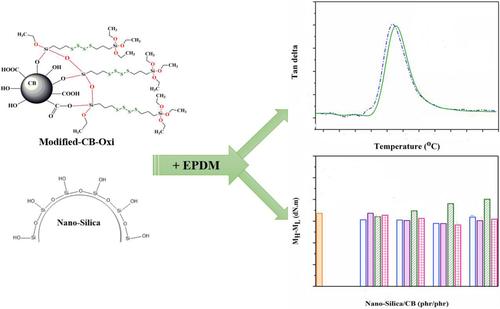硅烷改性炭黑和纳米二氧化硅单独或混合使用对乙烯-丙烯-二烯单体橡胶性能的影响
IF 4.7
2区 材料科学
Q2 MATERIALS SCIENCE, COMPOSITES
引用次数: 0
摘要
本研究评估了一种专门开发的表面改性炭黑作为乙烯-丙烯-二烯单体(EPDM)橡胶化合物的混合填料的有效性,这种炭黑既可以单独使用,也可以与纳米二氧化硅结合使用。改性过程包括使用硅烷偶联剂进行处理,从而提高了固化特性。含有改性炭黑的化合物的 ΔTorque 值比其他配方高出 25.85%。扫描电子显微镜(SEM)分析表明,由于表面改性,填料的分散性得到改善,橡胶与填料之间的相容性更好。硅烷改性炭黑的机械性能,尤其是抗撕裂性能显著提高,表面处理后的拉伸强度和撕裂强度分别提高了 22.46% 和 34.86%。动态机械分析(DMA)显示了表面改性和填料类型的影响,改性炭黑和纳米二氧化硅的组合降低了 20.41% 的滚动阻力,提高了 7.95% 的冰面和湿地抓地性能。此外,改性炭黑对玻璃化转变温度也有不同的影响。热重分析(TGA)证实,这些化合物的热稳定性是一致的,而耐溶剂性则随着表面改性的进行而提高,这一点可以从膨胀比中看出。热力学分析表明,炭黑的表面改性对所研究的橡胶化合物的弹性和链流动性有积极影响。总之,仔细选择和优化填充材料及其改性对于定制橡胶复合物的性能以满足特定性能标准和应用至关重要。本文章由计算机程序翻译,如有差异,请以英文原文为准。

The effect of silane-modified carbon black and nano-silica, individually and in combination, on the performance of ethylene–propylene–diene monomer rubber
This study assesses the effectiveness of a specially developed surface-modified carbon black, both on its own and in combination with nano-silica, as a hybrid filler for ethylene–propylene–diene monomer (EPDM) rubber compounds. The modification process, which included treatment with a silane coupling agent, resulted in enhanced curing characteristics. The ∆Torque values for compounds incorporating the modified carbon black exceeded those of other formulations by 25.85%. Scanning electron microscopy (SEM) analysis demonstrated improved filler dispersion and better compatibility between rubber and filler due to the surface modification. The silane-modified carbon black showed considerable enhancements in mechanical properties, particularly in tear resistance, with increases in tensile and tear strength of 22.46% and 34.86%, respectively, following surface treatment. Dynamic mechanical analysis (DMA) indicated the influence of both surface modification and filler type, revealing that the combination of modified carbon black and nano-silica achieved a reduction in rolling resistance of 20.41% and enhanced ice and wet grip performance by 7.95%. Additionally, modified carbon black displayed varying effects on the glass transition temperature. Thermal gravimetric analysis (TGA) confirmed that the thermal stability of the compounds was consistent, while solvent resistance improved with surface modification, as shown by swelling ratios. Thermodynamic analysis indicated that the surface modification of carbon black positively influences the elasticity and chain mobility of the rubber compounds studied. In conclusion, the careful selection and optimization of filler materials and their modifications are essential for customizing the properties of rubber compounds to satisfy specific performance criteria and applications.
求助全文
通过发布文献求助,成功后即可免费获取论文全文。
去求助
来源期刊

Polymer Composites
工程技术-材料科学:复合
CiteScore
7.50
自引率
32.70%
发文量
673
审稿时长
3.1 months
期刊介绍:
Polymer Composites is the engineering and scientific journal serving the fields of reinforced plastics and polymer composites including research, production, processing, and applications. PC brings you the details of developments in this rapidly expanding area of technology long before they are commercial realities.
 求助内容:
求助内容: 应助结果提醒方式:
应助结果提醒方式:


